
Cambridge is a city in Middlesex County, Massachusetts, United States, situated directly north of Boston, across the Charles River. It was named in honor of the University of Cambridge in England, an important center of the Puritan theology embraced by the town's founders. Cambridge is home to two of the world's most prominent universities, Harvard University and the Massachusetts Institute of Technology. Radcliffe College, once one of the leading colleges for women in the United States, was also located in Cambridge before it merged with Harvard. According to the 2010 United States Census, the city's population was 105,162.[3] It is the fifth most populous city in the state, behind Boston, Worcester, Springfield, and Lowell.[3] Cambridge was one of the two county seats of Middlesex County prior to the abolition of county government in 1997; Lowell was the other.
History
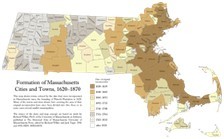
A map showing the original boundaries of Cambridge and other Massachusetts cities and towns
The site for what would become Cambridge was chosen in December 1630, because it was located safely upriver from Boston Harbor, which made it easily defensible from attacks by enemy ships. Also, the water from the local spring was so good that the local Native Americans believed it had medicinal properties.[citation needed]Thomas Dudley, his daughter Anne Bradstreet and her husband Simon were among the first settlers of the town. The first houses were built in the spring of 1631. The settlement was initially referred to as "the newetowne."[4] Official Massachusetts records show the name capitalized as Newe Towne by 1632.[5] Located at the first convenient Charles River crossing west of Boston, Newe Towne was one of a number of towns (including Boston, Dorchester, Watertown, and Weymouth) founded by the 700 original Puritan colonists of the Massachusetts Bay Colony under governor John Winthrop. The original village site is in the heart of today's Harvard Square. The marketplace where farmers brought in crops from surrounding towns to sell survives today as the small park at the corner of John F. Kennedy (J.F.K.) and Winthrop Streets, then at the edge of a salt marsh, since filled. The town included a much larger area than the present city, with various outlying parts becoming independent towns over the years: Newton (originally Cambridge Village, then Newtown) in 1688,[6]Lexington (Cambridge Farms) in 1712, and both West Cambridge (originally Menotomy) and Brighton (Little Cambridge) in 1807.[7] Part of West Cambridge joined the new town of Belmont in 1859, and the rest of West Cambridge was renamed Arlington in 1867; Brighton was annexed by Boston in 1874. In the late 19th century, various schemes for annexing Cambridge itself to the City of Boston were pursued and rejected.
In 1636, the Newe College (later renamed Harvard College, after benefactor John Harvard), was founded by the colony to train ministers. Newe Towne (later named Cambridge) was chosen for the site of the new college by the Great and General Court (the Massachusetts legislature)...primarily, according to testimony by Cotton Mather, to be near the highly respected, popular Puritan preacher Thomas Shepard. By 1638, the name "Newe Towne" had "compacted by usage into 'Newtowne'."[4] In May 1638[10][11] the name was changed to Cambridge in honor of the university in Cambridge, England.[12] Thomas Shepard, the minister of Cambridge's church...Harvard's first president (Henry Dunster)... its first benefactor (John Harvard)... and the first schoolmaster (Nathaniel Eaton) were all Cambridge University alumni...as was the then ruling (and first) governor of the Massachusetts Bay Colony, John Winthrop. In 1629, Winthrop had led the signing of the founding document of the city of Boston, which was known as the Cambridge Agreement, after the university.[13] It was Governor Thomas Dudley who, in 1650, signed the charter creating the corporation which still governs Harvard College.
George Washington in Cambridge, 1775
Cambridge grew slowly as an agricultural village eight miles (13 km) by road from Boston, the capital of the colony. By the American Revolution, most residents lived near the Common and Harvard College, with farms and estates comprising most of the town. Most of the inhabitants were descendants of the original Puritan colonists, but there was also a small elite of Anglican "worthies" who were not involved in village life, who made their livings from estates, investments, and trade, and lived in mansions along "the Road to Watertown" (today's Brattle Street, still known as Tory Row). In 1775, George Washington came up from Virginia to take command of fledgling volunteer American soldiers camped on the Cambridge Common—today called the birthplace of the U.S. Army. (The name of today's nearby Sheraton Commander Hotel refers to that event.) Most of the Tory estates were confiscated after the Revolution. On January 24, 1776, Henry Knox arrived with artillery captured from Fort Ticonderoga, which enabled Washington to drive the British army out of Boston.
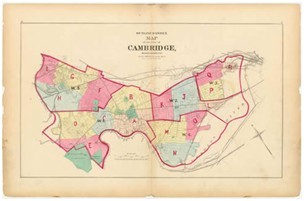
A map of Cambridge from 1873
Between 1790 and 1840, Cambridge began to grow rapidly, with the construction of the West Boston Bridge in 1792, that connected Cambridge directly to Boston, making it no longer necessary to travel eight miles (13 km) through the Boston Neck, Roxbury, and Brookline to cross the Charles River. A second bridge, the Canal Bridge, opened in 1809 alongside the new Middlesex Canal. The new bridges and roads made what were formerly estates and marshland into prime industrial and residential districts.
In the mid-19th century, Cambridge was the center of a literary revolution when it gave the country a new identity through poetry and literature. Cambridge was home to some of the famous Fireside Poets—so called because their poems would often be read aloud by families in front of their evening fires. In their day, the Fireside Poets—Henry Wadsworth Longfellow, James Russell Lowell, and Oliver Wendell Holmes—were as popular and influential as rock stars are today.
Soon after, turnpikes were built: the Cambridge and Concord Turnpike (today's Broadway and Concord Ave.), the Middlesex Turnpike (Hampshire St. and Massachusetts Ave. northwest of Porter Square), and what are today's Cambridge, Main, and Harvard Streets were roads to connect various areas of Cambridge to the bridges. In addition, railroads crisscrossed the town during the same era, leading to the development of Porter Square as well as the creation of neighboring town Somerville from the formerly rural parts of Charlestown.

1852 Map of Boston area showing Cambridge and regional rail lines and highlighting the course of the Middlesex Canal. Cambridge is toward the bottom of the map and outlined in yellow, and should not be confused with the pink-outlined and partially cropped "West Cambridge", now Arlington.
Cambridge was incorporated as a city in 1846. This was despite noticeable tensions between East Cambridge, Cambridgeport, and Old Cambridge that stemmed from differences in each area's culture, sources of income, and the national origins of the residents.[16] The city's commercial center began to shift from Harvard Square to Central Square, which became the downtown of the city around this time. Between 1850 and 1900, Cambridge took on much of its present character—streetcar suburban development along the turnpikes, with working-class and industrial neighborhoods focused on East Cambridge, comfortable middle-class housing being built on old estates in Cambridgeport and Mid-Cambridge, and upper-class enclaves near Harvard University and on the minor hills of the city. The coming of the railroad to North Cambridge and Northwest Cambridge then led to three major changes in the city: the development of massive brickyards and brickworks between Massachusetts Ave., Concord Ave. and Alewife Brook; the ice-cutting industry launched by Frederic Tudor on Fresh Pond; and the carving up of the last estates into residential subdivisions to provide housing to the thousands of immigrants that arrived to work in the new industries.
For many decades, the city's largest employer was the New England Glass Company, founded in 1818. By the middle of the 19th century it was the largest and most modern glassworks in the world. In 1888, all production was moved, by Edward Drummond Libbey, to Toledo, Ohio, where it continues today under the name Owens Illinois. Flint glassware with heavy lead content, produced by that company, is prized by antique glass collectors today. There is none on public display in Cambridge, but there is a large collection in the Toledo Museum of Art. There are also a few pieces in the Museum of Fine Arts, Boston and in the Sandwich (Cape Cod, MA) Glass Museum.
Among the largest businesses located in Cambridge was the firm of Carter's Ink Company, whose neon sign long adorned the Charles River and which was for many years the largest manufacturer of ink in the world.
By 1920, Cambridge was one of the main industrial cities of New England, with nearly 120,000 residents. As industry in New England began to decline during the Great Depression and after World War II, Cambridge lost much of its industrial base. It also began the transition to being an intellectual, rather than an industrial, center. Harvard University had always been important in the city (both as a landowner and as an institution), but it began to play a more dominant role in the city's life and culture. When Radcliffe College was established in 1879 the town became a mecca for some of the nation's most academically talented female students. Also, the move of the Massachusetts Institute of Technology from Boston in 1916 ensured Cambridge's status as an intellectual center of the United States.
After the 1950s, the city's population began to decline slowly, as families tended to be replaced by single people and young couples. The 1980s brought a wave of high-technology startups, creating software such as Visicalc and Lotus 1-2-3, and advanced computers, but many of these companies fell into decline with the fall of the minicomputer and DOS-based systems. However, the city continues to be home to many startups as well as a thriving biotech industry. By the end of the 20th century, Cambridge had one of the most expensive housing markets in the Northeastern United States.
While maintaining much diversity in class, race, and age, it became harder and harder for those who grew up in the city to be able to afford to stay. The end of rent control in 1994 prompted many Cambridge renters to move to housing that was more affordable, in Somerville and other communities. In 2005, a reassessment of residential property values resulted in a disproportionate number of houses owned by non-affluent people jumping in value relative to other houses, with hundreds having their property tax increased by over 100%; this forced many homeowners in Cambridge to move elsewhere.[17]
As of 2012, Cambridge's mix of amenities and proximity to Boston has kept housing prices relatively stable despite the bursting of the United States housing bubble.[citation needed] Cambridge has been a sanctuary city since 1985 and reaffirmed its status as such in 2006.[18][19]
Geography
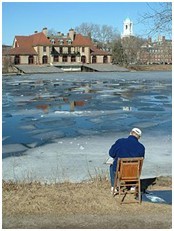
A view from Boston of Harvard's Weld Boathouse and Cambridge in winter. The Charles River is in the foreground.
According to the United States Census Bureau, Cambridge has a total area of 7.1 square miles (18 km2), of which 6.4 square miles (17 km2) of it is land and 0.7 square miles (1.8 km2) of it (9.82%) is water.
Adjacent municipalities
Cambridge is located in eastern Massachusetts, bordered by:
• the city of Boston to the south (across the Charles River) and east
• the city of Somerville to the north
• the town of Arlington to the northwest
• the town of Belmont and
• the city of Watertown to the west
The border between Cambridge and the neighboring city of Somerville passes through densely populated neighborhoods which are connected by the MBTA Red Line. Some of the main squares, Inman, Porter, and to a lesser extent, Harvard, are very close to the city line, as are Somerville's Union and Davis Squares.
Neighborhoods
Squares
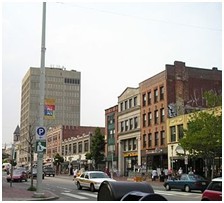
Central Square
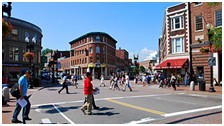
Harvard Square
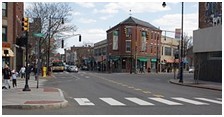
Inman Square
Cambridge has been called the "City of Squares" by some,[20][21] as most of its commercial districts are major street intersections known as squares. Each of the squares acts as a neighborhood center. These include:
• Kendall Square, formed by the junction of Broadway, Main Street, and Third Street, is also known as Technology Square, a name shared with an office and laboratory building cluster in the neighborhood. Just over the Longfellow Bridge from Boston, at the eastern end of the MIT campus, it is served by the Kendall/MIT station on the MBTARed Line subway. Most of Cambridge's large office towers are located here, giving the area somewhat of an office park feel. A flourishing biotech industry has grown up around this area. The "One Kendall Square" complex is nearby, but—confusingly—not actually in Kendall Square. Also, the "Cambridge Center" office complex is located here, and not at the actual center of Cambridge.
• Central Square, formed by the junction of Massachusetts Avenue, Prospect Street, and Western Avenue, is well known for its wide variety of ethnic restaurants. As recently as the late 1990s it was rather run-down; it underwent a controversial gentrification in recent years (in conjunction with the development of the nearby University Park at MIT), and continues to grow more expensive. It is served by the Central Station stop on the MBTA Red Line subway. Lafayette Square, formed by the junction of Massachusetts Avenue, Columbia Street, Sidney Street, and Main Street, is considered part of the Central Square area. Cambridgeport is south of Central Square along Magazine Street and Brookline Street.
• Harvard Square, formed by the junction of Massachusetts Avenue, Brattle Street, and JFK Street. This is the primary site of Harvard University, and is a major Cambridge shopping area. It is served by a Red Line station. Harvard Square was originally the northwestern terminus of the Red Line and a major transfer point to streetcars that also operated in a short tunnel—which is still a major bus terminal, although the area under the Square was reconfigured dramatically in the 1980s when the Red Line was extended. The Harvard Square area includes Brattle Square and Eliot Square. A short distance away from the square lies the Cambridge Common, while the neighborhood north of Harvard and east of Massachusetts Avenue is known as Agassiz in honor of the famed scientist Louis Agassiz.
• Porter Square, about a mile north on Massachusetts Avenue from Harvard Square, is formed by the junction of Massachusetts and Somerville Avenues, and includes part of the city of Somerville. It is served by the Porter Square Station, a complex housing a Red Line stop and a Fitchburg Linecommuter rail stop. Lesley University's University Hall and Porter campus are located at Porter Square.
• Inman Square, at the junction of Cambridge and Hampshire streets in Mid-Cambridge. Inman Square is home to many diverse restaurants, bars, music venues and boutiques. The funky street scene still holds some urban flair, but was dressed up recently with Victorian streetlights, benches and bus stops. A new community park was installed and is a favorite place to enjoy some takeout food from the nearby restaurants and ice cream parlor.
• Lechmere Square, at the junction of Cambridge and First streets, adjacent to the CambridgeSide Galleria shopping mall. Perhaps best known as the northern terminus of the MBTAGreen Line subway, at Lechmere Station.
Other neighborhoods
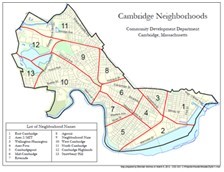
Neighborhood Map of Cambridge
The residential neighborhoods in Cambridge border, but are not defined by the squares. These neighborhoods include:
• East Cambridge (Area 1) is bordered on the north by the Somerville border, on the east by the Charles River, on the south by Broadway and Main Street, and on the west by the Grand Junction Railroad tracks. It includes the NorthPoint development.
• MIT Campus (Area 2) is bordered on the north by Broadway, on the south and east by the Charles River, and on the west by the Grand Junction Railroad tracks.
• Wellington-Harrington (Area 3) is bordered on the north by the Somerville border, on the south and west by Hampshire Street, and on the east by the Grand Junction Railroad tracks. Referred to as "Mid-Block".
• Area 4 is bordered on the north by Hampshire Street, on the south by Massachusetts Avenue, on the west by Prospect Street, and on the east by the Grand Junction Railroad tracks. Residents of Area 4 often refer to their neighborhood simply as "The Port", and refer to the area of Cambridgeport and Riverside as "The Coast".
• Cambridgeport (Area 5) is bordered on the north by Massachusetts Avenue, on the south by the Charles River, on the west by River Street, and on the east by the Grand Junction Railroad tracks.
• Mid-Cambridge (Area 6) is bordered on the north by Kirkland and Hampshire Streets and the Somerville border, on the south by Massachusetts Avenue, on the west by Peabody Street, and on the east by Prospect Street.
• Riverside (Area 7), an area sometimes referred to as "The Coast," is bordered on the north by Massachusetts Avenue, on the south by the Charles River, on the west by JFK Street, and on the east by River Street.
• Agassiz (Harvard North) (Area 8) is bordered on the north by the Somerville border, on the south and east by Kirkland Street, and on the west by Massachusetts Avenue.
• Neighborhood Nine or Radcliffe (formerly called Peabody, until a recent relocation of a neighborhood school by that name) is bordered on the north by railroad tracks, on the south by Concord Avenue, on the west by railroad tracks, and on the east by Massachusetts Avenue.
The affluent Avon Hill sub-neighborhood consists of the higher elevations within the area bounded by Upland Road, Raymond Street, Linnaean Street and Massachusetts Avenue.
• Brattle area/West Cambridge (Area 10) is bordered on the north by Concord Avenue and Garden Street, on the south by the Charles River and the Watertown border, on the west by Fresh Pond and the Collins Branch Library, and on the east by JFK Street. It includes the sub-neighborhoods of Brattle Street (formerly known as Tory Row) and Huron Village.
• North Cambridge (Area 11) is bordered on the north by the Arlington and Somerville borders, on the south by railroad tracks, on the west by the Belmont border, and on the east by the Somerville border.
• Cambridge Highlands (Area 12) is bordered on the north and east by railroad tracks, on the south by Fresh Pond, and on the west by the Belmont border.
• Strawberry Hill (Area 13) is bordered on the north by Fresh Pond, on the south by the Watertown border, on the west by the Belmont border, and on the east by railroad tracks.
Parks and outdoors
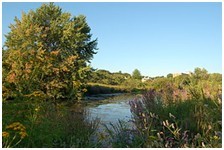
Alewife Brook Reservation
Consisting largely of densely built residential space, Cambridge lacks significant tracts of public parkland. This is partly compensated for, however, by the presence of easily accessible open space on the university campuses, including Harvard Yard, the Radcliffe Yard, and MIT's Great Lawn, as well as the considerable open space of Mount Auburn Cemetery. At the western edge of Cambridge, the cemetery is well known as the first garden cemetery, for its distinguished inhabitants, for its superb landscaping (the oldest planned landscape in the country), and as a first-rate arboretum. Although known as a Cambridge landmark, much of the cemetery lies within the bounds of Watertown.[22] It is also a significant Important Bird Area (IBA) in the Greater Boston area.
Public parkland includes the esplanade along the Charles River, which mirrors its Boston counterpart, Cambridge Common, a busy and historic public park immediately adjacent to the Harvard campus, and the Alewife Brook Reservation and Fresh Pond in the western part of the city.
Demographics
| Historical population | ||
| Year | Pop. | ±% |
| 1790 | 2,115 | — |
| 1800 | 2,453 | +16.0% |
| 1810 | 2,323 | −5.3% |
| 1820 | 3,295 | +41.8% |
| 1830 | 6,072 | +84.3% |
| 1840 | 8,409 | +38.5% |
| 1850 | 15,215 | +80.9% |
| 1860 | 26,060 | +71.3% |
| 1870 | 39,634 | +52.1% |
| 1880 | 52,669 | +32.9% |
| 1890 | 70,028 | +33.0% |
| 1900 | 91,886 | +31.2% |
| 1910 | 104,839 | +14.1% |
| 1920 | 109,694 | +4.6% |
| 1930 | 113,643 | +3.6% |
| 1940 | 110,879 | −2.4% |
| 1950 | 120,740 | +8.9% |
| 1960 | 107,716 | −10.8% |
| 1970 | 100,361 | −6.8% |
| 1980 | 95,322 | −5.0% |
| 1990 | 95,802 | +0.5% |
| 2000 | 101,355 | +5.8% |
| 2010 | 105,162 | +3.8% |
As of the census[34] of 2010, there were 105,162 people, 44,032 households, and 17,420 families residing in the city. The population density was 16,422.08 people per square mile (6,341.98/km²), making Cambridge the fifth most densely populated city in the US[35] and the second most densely populated city in Massachusetts behind neighboring Somerville.[36] There were 47,291 housing units at an average density of 7,354.7 per square mile (2,840.3/km²). The racial makeup of the city was 66.60% White, 11.70% Black or African American, 0.20% Native American, 15.10% Asian, 0.01% Pacific Islander, 2.10% from other races, and 4.30% from two or more races. 7.60% of the population wereHispanic or Latino of any race. Non-Hispanic Whites were 62.1% of the population in 2010,[37] down from 89.7% in 1970.[38] Cambridge has significantly more Asians, and fewer Hispanics and Caucasians than the average racial demographics of the United States. 11.0% were of Irish, 7.2% English, 6.9% Italian, 5.5% West Indian and 5.3% German ancestry according to Census 2000. 69.4% spoke English, 6.9% Spanish, 3.2% Chinese or Mandarin, 3.0% Portuguese, 2.9% French Creole, 2.3% French, 1.5% Korean, and 1.0% Italian as their first language.
There were 44,032 households out of which 16.9% had children under the age of 18 living with them, 28.9% were married couples living together, 8.4% had a female householder with no husband present, and 60.4% were non-families. 40.7% of all households were made up of individuals and 9.6% had someone living alone who was 65 years of age or older. The average household size was 2.00 and the average family size was 2.76.
In the city the population was spread out with 13.3% under the age of 18, 21.2% from 18 to 24, 38.6% from 25 to 44, 17.8% from 45 to 64, and 9.2% who were 65 years of age or older. The median age was 30.5 years. For every 100 females, there were 96.1 males. For every 100 females age 18 and over, there were 94.7 males.
The median income for a household in the city was $47,979, and the median income for a family was $59,423 (these figures had risen to $58,457 and $79,533 respectively as of a 2007 estimate[39]). Males had a median income of $43,825 versus $38,489 for females. The per capita income for the city was $31,156. About 8.7% of families and 12.9% of the population were below the poverty line, including 15.1% of those under age 18 and 12.9% of those age 65 or over.
Cambridge was ranked as one of the most liberal cities in America.[40] Locals living in and near the city jokingly refer to it as "The People's Republic of Cambridge."[41] For 2012, the residential property tax rate in Cambridge is $8.48 per $1,000.[42] Cambridge enjoys the highest possible bond credit rating, AAA, with all three Wall Street rating agencies.[43]
Cambridge is noted for its diverse population, both racially and economically. Residents, known as Cantabrigians, include affluent MIT and Harvard professors. The first legal applications in America for same-sex marriage licenses were issued at Cambridge's City Hall.[44]
Cambridge is also the birthplace of Thai king Bhumibol Adulyadej (Rama IX), who is the world's longest reigning monarch at age 82 (2010), as well as the longest reigning monarch in Thai history. He is also the first king of a foreign country to be born in the United States.
Government
Federal and state representation
| Voter registration and party enrollment as of October 15, 2008 (2008-10-15) | |||||
| Party | Number of voters | Percentage | |||
| Democratic | 37,822 | 58.43% | |||
| Republican | 3,280 | 5.07% | |||
| Unaffiliated | 22,935 | 35.43% | |||
| Minor Parties | 690 | 1.07% | |||
| Total | 64,727 | 100% | |||
Cambridge is split between Massachusetts's 5th congressional district, represented by Democrat Ed Markey, elected in 1976, and Massachusetts's 7th congressional district, represented by Democrat Mike Capuano, elected in 1998. The state's senior member of the United States Senate is Democrat Elizabeth Warren, elected in 2012, who lives in Cambridge. The Governor of Massachusetts is Democrat Deval Patrick, elected in 2006 and re-elected in 2010.
On the state level, Cambridge is represented in six districts in the Massachusetts House of Representatives: the 24th Middlesex (which includes parts of Belmont and Arlington), the 25th and 26th Middlesex (the latter which includes a portion of Somerville), the 29th Middlesex (which includes a small part of Watertown), and the Eighth and Ninth Suffolk (both including parts of the City of Boston). The city is represented in the Massachusetts Senate as a part of the "First Suffolk and Middlesex" district (this contains parts of Boston, Revere and Winthrop each in Suffolk County); the "Middlesex, Suffolk and Essex" district, which includes Everett and Somerville, with Boston, Chelsea, and Revere of Suffolk, and Saugus in Essex; and the "Second Suffolk and Middlesex" district, containing parts of the City of Boston in Suffolk County, and Cambridge, Belmont and Watertown in Middlesex County.[46] In addition to the Cambridge Police Department, the city is patrolled by the Fifth (Brighton) Barracks of Troop H of the Massachusetts State Police.[47] Due, however, to close proximity, the city also practices functional cooperation with the Fourth (Boston) Barracks of Troop H, as well.[48]
City government
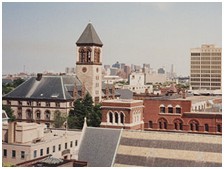
Cambridge City Hall in the 1980s
Cambridge has a city government led by a Mayor and nine-member City Council. There is also a six-member School Committee which functions alongside the Superintendent of public schools. The councilors and school committee members are elected every two years using the single transferable vote (STV) system.[49] Once a laborious process that took several days to complete by hand, ballot sorting and calculations to determine the outcome of elections are now quickly performed by computer, after the ballots have been optically scanned.
The mayor is elected by the city councilors from amongst themselves, and serves as the chair of City Council meetings. The mayor also sits on the School Committee. However, the Mayor is not the Chief Executive of the City. Rather, the City Manager, who is appointed by the City Council, serves in that capacity.
Under the City's Plan E form of government the city council does not have the power to appoint or remove city officials who are under direction of the city manager. The city council and its individual members are also forbidden from giving orders to any subordinate of the city manager.[50]
Richard C. Rossi is the City Manager; he succeeds Robert W. Healy, who retired in June 2013 after serving 32 years in the position. In recent history, the media has highlighted the salary of the City Manager as being one of the highest for a civic employee in Massachusetts.[51] Since the city manager is not elected, his job description might be better compared with those of large-enterprise business or non-profit managers, rather than with those of politicians.
The city council consists of:[52]
• Leland Cheung (Jan. 2010–present)
• Henrietta Davis (Jan. 1996–present)*
• Marjorie C. Decker (Jan. 2000–present)[53] She has been elected as a State Representative and is not running for re-election.
• Craig A. Kelley (Jan. 2006–present)
• David Maher (Jan. 2000-Jan. 2006, Sept. 2007–present[54])**
• Kenneth Reeves (Jan. 1990–present)**
• E. Denise Simmons (Jan. 2002–present)**
• Timothy J. Toomey, Jr. (Jan. 1990–present)



















